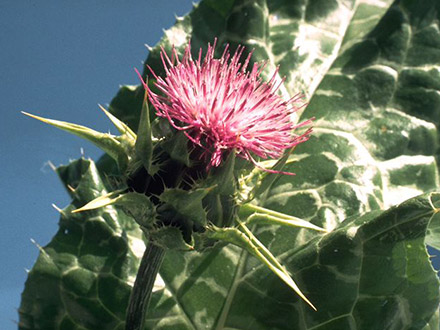Botanical name
Silybum marianum (L.) Gaertn. (syn. Carduus marianus L.)
Family
Asteraceae
Common name
Milk thistle, Mary thistle, Holy thistle, Blessed milk thistle
Information about the plant
The milk thistle is native to southern Europe, the Caucasus, Asia Minor, as well as North Africa and the Canary Islands and has been introduced in many other countries. It grows preferably on sunny, rocky slopes, on fences near houses, train stations and village roads. Milk thistle used for medicinal purposes is only obtained from cultivated crops.
The genus name Silybum is derived from the Greek "silibon" (etymologically Syllibon) = tassel. Thus, the plant should be called "Marienquaste" in German, but the translation of Linnaeus' name Carduus marianus was retained, which is now considered a synonym. 'Carduus' is Latin and means "thistle". Thistle is the name given to spiny plants from the Asteraceae family.
Milk thistle is an annual or biennial plant. It grows 60 to 150 cm high and flowers from June to September with purple daisy heads, which consist only of tubular flowers. Their thistle-like appearance is due to the outer bracts of the flower, ending in strong, sharp, thorny spikes. The individual lobes of the stalks, including the leaves, also end in pointy yellow spines. They are at the bottom of the stem and along the nerves, and are usually spotted and marbled in white. The brown-spotted fruit has a shiny white pappus as a flight element.
Medicinally used parts of plants (herbal drug)
The ripe fruit freed by the pappus is used. The commercially available drug is obtained exclusively from cultivations, partly in northern Germany, but it is mainly imported, primarily from Argentina, China, Romania and Hungary.
Constituents of the herbal drug
Milk thistle fruits contain “flavolignans” (silymarin complex), flavones, pentacyclic triterpenes and fatty oil.
Quality of the drug
The quality of the following drugs or drug preparations is specified in the European Pharmacopoeia (Ph. Eur.):
- Milk thistle fruits (Silybi mariani fructus)
- Milk thistle dried extract, refined and standardized (Silybi mariani extractum siccum raffinatum et normatum)
Medical applications
Recognised medical use
The HMPC has classified milk thistle fruit as a traditional herbal medicinal product (see "Traditional use").
ESCOP: Standardized milk thistle extract preparations and silymarin: for toxic liver disorders and for supportive treatment in chronic inflammatory liver diseases and hepatic cirrhosis.
Traditional use
Milk thistle fruits have been classified by the HMPC as a traditional herbal medicinal product (§ 39a AMG). Based upon long-standing use, milk thistle fruits can be used for relief of symptoms of digestive disorders, sensation of fullness and indigestion and to support liver function, after serious conditions have been excluded by a medical doctor.
Herbal drug preparations in finished dosage forms
- Milk thistle fruit dry extracts standardized for silymarin (DER from 25-40:1 to 60-70:1 - extractants: acetone, ethyl acetate or ethanol 96% V/V)
- Silybum marianum homeopathic mother tincture in liquid preparations
Dosage
Finished medicinal products: see patient information leaflet.
Teas are not recommended because they will not reach the effective dose.
Preparation of a tea
Not applicable
Notes
No safety studies are currently available for use during pregnancy and lactation; use in children and adolescents under the age of 18 is not recommended due to a lack of evidence.
Side effects
Mild gastrointestinal complaints may occur, sometimes also a headache and allergic symptoms.
Interactions
None known
References
Herbal drug monographs
HMPC (2018, 2024), ESCOP (2009), WHO Vol. 2
Further literature
Commentary on the European Pharmacopoeia (Milk thistle fruit, Nr. 1860; Adjusted, purified dry extract of milk thistle fruit, Nr. 2071)


